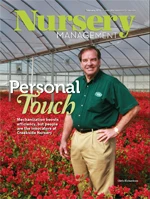|
In all my container and garden designs I consider foliage first. Flowers can be fickle, and when the foliage looks great and entertaining to the eye, then flowers are a bonus. Whether it’s bold leaves, glittering spillage or fine textured foliage, each plays an important part in the complete design. Grasses and grass-like plants offer graceful stature or cascading sweeps, bringing an exciting element to garden design. Perennial favorites I have had good success with eragrostis, nassella, fescue and the newer carex varieties. When grown from seed, these grasses and sedges generally grow faster than their vegetatively propagated relatives, they tend to have a fuller habit, and produce soft fine immature foliage that is pleasing to touch.
Eragrostis Eragrostis elliottii ‘Wind Dancer’ is a more formal looking grass that can be easily grown from seed or divisions, and gets 2-3 feet wide and rarely more than 2 feet tall. Festuca Festuca glauca (sheep’s fescue) is easily grown from seed, with its selected relatives more likely grown from divisions. All plants in this group are similarly beautiful, touchable grasses. They can be planted at the base and edge of containers. Carex I frequently use Carex hachijoensis ‘Evergold’ to cascade out of mixed containers of lysmachia, ligularia, hosta and heuchera. Many times I combine it with slower-growing conifers and evergreens like Buxus sempervivens ‘Variegata’ (variegated boxwood). The colorful mounds of C. testacea (orange hair sedge, prairie fire) prefer moist sunny conditions. C. testacea can be grown from divisions or seed and is hardy to Zone 6b. This sedge is one of the larger members of this family. It certainly looks great in a sunny perennial garden, but I love to mix it in containers with brightly colored annuals and tropical plants where it is perfect for separating large, bold and colorful foliage. There are several new carex varieties due primarily to the work of breeders and major seed producers that recently found a way to propagate large volumes of true-to-name varieties that previously were propagated from divisions. The vegetatively propagated C. albula ‘Frosty Curls’ has a seed produced counterpart named ‘Amazon Mist.’ C. comans ‘Bronze Form’ has a seed relative known as C. flagellifera ‘Bronzita.’ Production of these newer introductions ranges from12-16 weeks, but their holding capacity in the final growing container extends far beyond that, making this group an excellent choice for retail production. The seed varieties consistently have soft immature foliage, more uniform growth and finish quicker than the plants produced from divisions.
There are many forms of papyrus or true cyperus. Some are short, others tall and several in-between. These plants tolerate soggy, bog conditions, but grow equally well in containers with a variety of plants. They can grow in a pot without a drain-hole or they can be at home with annual and perennial mixes. Most can tolerate full sun, but grow in shady locations, too. This is truly an untapped source for form and drama in the garden. Rita Randolph is owner, Randolph’s Greenhouses, (731) 422-2768; www.randolphsgreenhouses.com. |

Explore the February 2011 Issue
Check out more from this issue and find your next story to read.
Latest from Nursery Management
- A letter from the sponsor: Janna Beckerman, Envu
- John Ruter shares UGA's latest woody and herbaceous ornamental plant breeding projects
- Voting now open for National Garden Bureau's 2026 Green Thumb Award Winners
- Conor Foy joins EHR's national sales team
- Pantone announces its 2026 Color of the Year
- Syngenta granted federal registration for Trefinti nematicide/fungicide in ornamental market
- Get to know Kayela Aeppli
- HILA 2025 video highlights: John Gaydos of Proven Winners









